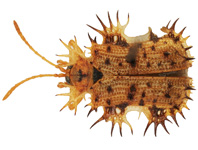Abstract
A new genus and species of solitary entoproct, Emschermannia ramificata, is described from the Kara Sea. It is an epibiont of the nephtyid polychaete Aglaophamus malmgreni, collected from 25–472 m depth. The species is about 250–300 μm long, with 8–10 tentacles, and buds are formed from a frontal area of the calyx. The calyx and stalk are not separated from each other by a cuticular septum, and a star-cell complex is absent. Emschermannia ramificata attaches to a substratum via a basal plate from which pseudostolons grow. Zooidal morphology conforms to that of the Loxosomatidae, but the attachment structure is unique among solitary entoprocts; it resembles basal plates and stolons of colonial entoprocts, but pseudostolons of Emschermannia serve only for attachment, not for budding. Overall, the morphology of Emschermannia may be considered intermediate between that of solitary and colonial forms, with relevance to evolutionary development within Entoprocta.
References
Annandale, N. (1915) Fauna of the Chilka Lake. The Polyzoa of the lake and of brackish water in the Gangetic delta. Memoirs of the India Museum, 5, 119–133.
Brien, P. (1959) Classe des Endoproctes ou Kamptozoaries. Traité de Zoologie, 5 (1), 927–1007.
Emschermann, P. (1972) Loxokalypus socialis gen. et sp. nov. (Kamptozoa, Loxokalypodidae fam. nov.), ein neuer Kamptozoentyp aus dem nördlichen Pazifischen Ozean. Ein Vorschlag zur Neufassung der Kamptozoensystematik. Marine Biology, 12, 237–254.
http://dx.doi.org/10.1007/BF00346772Emschermann, P. (1993) On Antarctic Entoprocta: nematocyst-like organs in a loxosomatid, adaptive developmental strategies, host specificity and bipolar occurrence of species. Biological Bulletin, 184, 153–185.
http://dx.doi.org/10.2307/1542225Fuchs, J., Iseto, T., Hirose, M., Sundberg, P. & Obst, M. (2010) The first internal molecular phylogeny of the animal phylum Entoprocta (Kamptozoa). Molecular Phylogenetics and Evolution, 56, 370–379.
http://dx.doi.org/10.1016/j.ympev.2010.04.009Hyman, L.H. (1951) The Invertebrates: Acanthocephala, Aschelminthes and Entoprocta. The pseudocoelomate Bilateria. Vol. III. McGraw-Hill, New York, London, Toronto, 572 pp.
Marcus, E. (1939) Briozoarios marinhos brasileiros III. Boletim da Faculdade de Filosofia, Ciências e Letras, Universidade de Sao Paulo, Zoologia, 3, 111–299.
Nielsen, C. (1964) Studies on Danish Entoprocta. Ophelia, 1, 1–76.
http://dx.doi.org/10.1080/00785326.1964.10416272Nielsen, C. (1989) Entoprocts: Keys and notes for the identification of the species. Synopses of the British Fauna, New Series, 41, 1–131.
Nielsen, C. & Jespersen, Å. (1997) Entoprocta. In: Harrison, F.W. & Woollacott, R.M. (Eds.), Microscopic Anatomy of Invertebrates. Vol. 13. Lophophorates, Entoprocta, and Cycliophora. Wiley-Liss, New York, pp. 13–43.
Schwaha, T., Wood, T.S. & Wanninger, A. (2010) Trapped in freshwater: the internal anatomy of the entoproct Loxosomatoides sirindhornae. Frontiers in Zoology, 7 (7), 1–15.
http://dx.doi.org/10.1186/1742-9994-7-7Wasson, K. (2002) A review of the invertebrate phylum Kamptozoa (Entoprocta) and synopsis of kamptozoan diversity in Australia and New Zealand. Transactions of the Royal Society of South Austalia, 126, 1–20.
Wood, T.S. (2005) Loxosomatoides sirindhornae, new species, a freshwater kamptozoan from Thailand (Entoprocta). Hydrobiologia, 544, 27–31.
http://dx.doi.org/10.1007/s10750-004-7909-x

